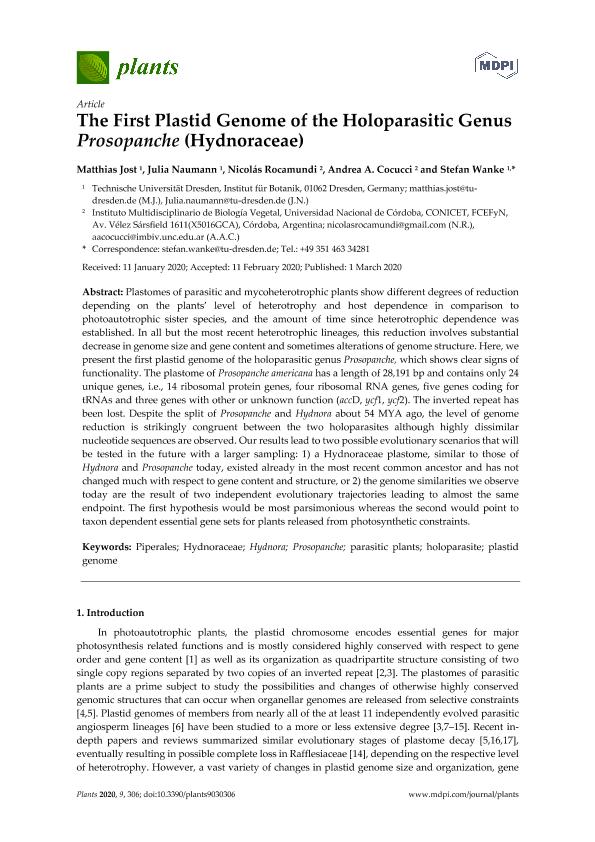Mostrar el registro sencillo del ítem
dc.contributor.author
Jost, Matthias
dc.contributor.author
Naumann, Julia
dc.contributor.author
Rocamundi, Nicolás

dc.contributor.author
Cocucci, Andrea Aristides

dc.contributor.author
Wanke, Stefan
dc.date.available
2020-06-05T18:15:43Z
dc.date.issued
2020-03
dc.identifier.citation
Jost, Matthias; Naumann, Julia; Rocamundi, Nicolás; Cocucci, Andrea Aristides; Wanke, Stefan; The first plastid genome of the Holoparasitic Genus Prosopanche (Hydnoraceae); MPDI; Plants; 9; 3; 3-2020
dc.identifier.issn
2223-7747
dc.identifier.uri
http://hdl.handle.net/11336/106767
dc.description.abstract
Plastomes of parasitic and mycoheterotrophic plants show different degrees of reduction depending on the plants' level of heterotrophy and host dependence in comparison to photoautotrophic sister species, and the amount of time since heterotrophic dependence was established. In all but the most recent heterotrophic lineages, this reduction involves substantial decrease in genome size and gene content and sometimes alterations of genome structure. Here, we present the first plastid genome of the holoparasitic genus Prosopanche, which shows clear signs of functionality. The plastome of Prosopanche americana has a length of 28,191 bp and contains only 24 unique genes, i.e., 14 ribosomal protein genes, four ribosomal RNA genes, five genes coding for tRNAs and three genes with other or unknown function (accD, ycf1, ycf2). The inverted repeat has been lost. Despite the split of Prosopanche and Hydnora about 54 MYA ago, the level of genome reduction is strikingly congruent between the two holoparasites although highly dissimilar nucleotide sequences are observed. Our results lead to two possible evolutionary scenarios that will be tested in the future with a larger sampling: 1) a Hydnoraceae plastome, similar to those ofHydnora and Prosopanche today, existed already in the most recent common ancestor and has not changed much with respect to gene content and structure, or 2) the genome similarities we observe today are the result of two independent evolutionary trajectories leading to almost the same end point. The first hypothesis would be most parsimonious whereas the second would point totaxon dependent essential gene sets for plants released from photosynthetic constraints.
dc.format
application/pdf
dc.language.iso
eng
dc.publisher
MPDI
dc.rights
info:eu-repo/semantics/openAccess
dc.rights.uri
https://creativecommons.org/licenses/by-nc-sa/2.5/ar/
dc.subject
PIPERALES
dc.subject
HYDNORACEAE
dc.subject
PARASITIC PLANTS
dc.subject
PLASTID GENOME
dc.subject.classification
Otros Tópicos Biológicos

dc.subject.classification
Ciencias Biológicas

dc.subject.classification
CIENCIAS NATURALES Y EXACTAS

dc.title
The first plastid genome of the Holoparasitic Genus Prosopanche (Hydnoraceae)
dc.type
info:eu-repo/semantics/article
dc.type
info:ar-repo/semantics/artículo
dc.type
info:eu-repo/semantics/publishedVersion
dc.date.updated
2020-06-02T13:37:19Z
dc.identifier.eissn
2223-7747
dc.journal.volume
9
dc.journal.number
3
dc.journal.pais
Suiza

dc.journal.ciudad
Basilea
dc.description.fil
Fil: Jost, Matthias. Technische Universität Dresden.; Alemania
dc.description.fil
Fil: Naumann, Julia. Technische Universität Dresden.; Alemania
dc.description.fil
Fil: Rocamundi, Nicolás. Consejo Nacional de Investigaciones Científicas y Técnicas. Centro Científico Tecnológico Conicet - Córdoba. Instituto Multidisciplinario de Biología Vegetal. Universidad Nacional de Córdoba. Facultad de Ciencias Exactas Físicas y Naturales. Instituto Multidisciplinario de Biología Vegetal; Argentina
dc.description.fil
Fil: Cocucci, Andrea Aristides. Consejo Nacional de Investigaciones Científicas y Técnicas. Centro Científico Tecnológico Conicet - Córdoba. Instituto Multidisciplinario de Biología Vegetal. Universidad Nacional de Córdoba. Facultad de Ciencias Exactas Físicas y Naturales. Instituto Multidisciplinario de Biología Vegetal; Argentina
dc.description.fil
Fil: Wanke, Stefan. Technische Universität Dresden.; Alemania
dc.journal.title
Plants
dc.relation.alternativeid
info:eu-repo/semantics/altIdentifier/url/https://www.mdpi.com/2223-7747/9/3/306
dc.relation.alternativeid
info:eu-repo/semantics/altIdentifier/doi/http://dx.doi.org/10.3390/plants9030306
Archivos asociados
